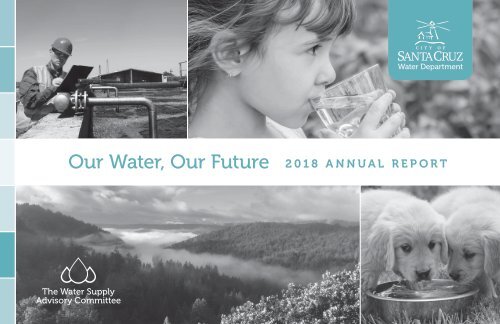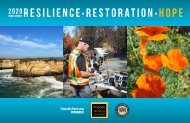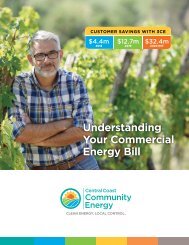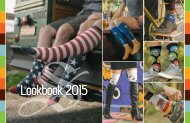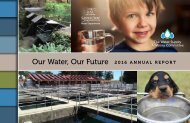WSAC Annual Report 2018
Santa Cruz Water Department The Water Supply Advisory Committee
Santa Cruz Water Department
The Water Supply Advisory Committee
Create successful ePaper yourself
Turn your PDF publications into a flip-book with our unique Google optimized e-Paper software.
Our Water, Our Future<br />
<strong>2018</strong> ANNUAL REPORT
Dear Resident,<br />
<strong>2018</strong> was a productive year of work on<br />
projects related to securing Santa Cruz’s<br />
water supply.<br />
It’s been three years since the Santa Cruz City<br />
Council approved recommendations made<br />
by the Water Supply Advisory Committee<br />
(<strong>WSAC</strong>) to help ensure that our water supply<br />
is secure and reliable, and in <strong>2018</strong>,<br />
significant progress was made on the<br />
key recommendations.<br />
First a quick recap – the Water Supply<br />
Advisory Committee included 14 Santa Cruz/<br />
Live Oak residents who were appointed by<br />
the City Council in 2014 to address the City’s<br />
water supply challenges. The group met for 18<br />
months and did a deep technical dive into the<br />
City’s water system. The <strong>WSAC</strong> identified the<br />
water supply gap that needs to be filled, and<br />
made several recommendations for potential<br />
ways to meet the gap.<br />
At the end of their process, the <strong>WSAC</strong><br />
recommended that along with increased water<br />
conservation, the City explore the following<br />
elements to supplement water supply:<br />
0 I Increase water conservation<br />
1 I Explore sharing water with other<br />
water districts<br />
2 I Store available winter water in<br />
underground aquifers<br />
3 I Use purified recycled water and<br />
desalinated water to meet the supply gap<br />
The <strong>WSAC</strong> also recommended that the<br />
Water Department study the feasibility of<br />
all recommendations at the same time, so<br />
that by 2020 a fully informed decision can<br />
be made on which recommendation(s) to<br />
implement. This report will update you on<br />
the progress that was made in <strong>2018</strong> to<br />
inform that decision.<br />
Sincerely,<br />
Rosemary Menard, Water Director,<br />
Santa Cruz Water Department<br />
2
Increased Conservation<br />
Recommendation:<br />
Reduce demand by an additional<br />
200-250 million gallons per year<br />
by 2035 through expanded<br />
water conservation programs.<br />
Did You Know?<br />
0%<br />
Even with projected growth,<br />
water use is expected to remain<br />
flat due to price, conservation,<br />
and new plumbing and<br />
building codes.<br />
ELEMENT<br />
0<br />
As a precautionary measure resulting<br />
from the low rainfall and runoff in<br />
the winter of 2017-18, Stage 1 water<br />
restrictions were imposed during the dry<br />
season of <strong>2018</strong>. The following activities<br />
were undertaken to further goals for<br />
water conservation. In <strong>2018</strong>, we:<br />
• Continued to offer a robust suite of<br />
conservation programs including rebate<br />
programs, home water surveys, large<br />
landscape budgets and others.<br />
• Created a new home water use report<br />
program for top single-family residential<br />
customers. The water reports will<br />
provide a comparison of the customer’s<br />
usage pattern to that of similar efficient<br />
households. This program is scheduled<br />
to launch in spring 2019.<br />
• Finished a pilot project to identify<br />
and recover leaks through advanced<br />
water meter technology with a group<br />
of 350 large irrigation meter accounts,<br />
including local community parks<br />
and schools.<br />
• Completed a study of advanced water<br />
meter technology for Santa Cruz.<br />
This study looked at appropriate<br />
technologies as well as the costs and<br />
benefits of implementation.<br />
• Reached the milestone of more than<br />
10,000 clothes washer rebates provided<br />
to customers since the program began<br />
in the year 2000.<br />
• Continued to improve upon the large<br />
landscape water budget program<br />
by introducing new online mapping<br />
technology for customers to view<br />
site maps and suggest edits to their<br />
landscaped areas.<br />
• Followed average residential water use<br />
per capita at 48 gallons per person per<br />
day (among the lowest levels<br />
in California).<br />
• Improved the accuracy of our annual<br />
water loss audit report, which<br />
demonstrates a declining trend in<br />
system leakage in <strong>2018</strong>.<br />
3
Recommendation:<br />
Explore sharing water with<br />
other water districts (also<br />
known as In Lieu).<br />
4<br />
Develop agreements to deliver<br />
surface water to Soquel Creek<br />
Water District and/or Scotts<br />
Valley Water District so that they<br />
could potentially rest their wells,<br />
help the aquifers recover and<br />
effectively store water for use by<br />
Santa Cruz Water Department<br />
during drought years.<br />
Did You Know?<br />
In-Lieu<br />
Recharge<br />
of aquifers provides water from<br />
another source in lieu of drawing<br />
water from an aquifer, so the<br />
aquifer can rest and recharge.<br />
ELEMENT<br />
1<br />
Explore Sharing Water with<br />
Other Water Districts<br />
Ninety-five percent of Santa Cruz’s water supply is surface water, from creeks and<br />
rivers; Soquel Creek and Scotts Valley water supplies are 100% groundwater from<br />
aquifers. The chemistry of surface water and groundwater is different, and may<br />
require different treatment. After two years of analysis to confirm the compatibility of<br />
Santa Cruz surface water and Soquel Creek Water District groundwater, a formal pilot<br />
water-sharing project began on December 3, <strong>2018</strong>. During the pilot, water quality and<br />
groundwater levels where water is no longer being drawn from will be studied.<br />
You can think of water exchanges/in-lieu as “banking” water for use in the future.<br />
By water districts using surface water in-lieu of using groundwater, aquifers are able<br />
to rest and recharge with water. Then, during dry times when surface water is in short<br />
supply, water supply may be drawn from recharged aquifers.
Recommendation:<br />
Explore using winter water<br />
from the City’s flowing water<br />
sources to recharge regional<br />
aquifers (also known as Aquifer<br />
Storage and Recovery or ASR).<br />
Use existing infrastructure such<br />
as wells and pipelines, as well<br />
as create new infrastructure, to<br />
store excess water in regional<br />
aquifers that can then be used<br />
by Santa Cruz Water Department<br />
during drought years.<br />
Did You Know?<br />
300 miles<br />
of pipes<br />
The average cost to replace a<br />
mile of water main is $2.2M and<br />
Santa Cruz has over 300 miles of<br />
pipes in the system.<br />
ELEMENT<br />
2<br />
Store Available Winter Water<br />
in Underground Aquifers<br />
Much progress was made on ASR in <strong>2018</strong>. Most significantly, an initial set of<br />
groundwater modeling scenarios for the Santa Margarita and Mid-County<br />
groundwater basins were completed, helping to direct ASR efforts to areas where<br />
they might have the most positive impacts on the basins.<br />
Based on the positive results of the modeling, the decision was made to proceed<br />
to Phase 2 of the ASR feasibility study for the Mid-County Groundwater Basin.<br />
Phase 2 includes installing temporary modifications at the Department’s Beltz 12<br />
wellsite, as well as permitting and pilot testing. Pilot testing in the Mid-County Basin<br />
begins in early 2019, while identifying a pilot test location in the Santa Margarita<br />
Basin continues.<br />
5
Recommendation:<br />
Explore creating a potable<br />
water supply through advanced<br />
treated recycled water options<br />
or by desalination.<br />
Use advanced treated recycled<br />
water to supplement or<br />
replace supply in the event the<br />
groundwater storage strategies<br />
prove insufficient to meet the<br />
cost effectiveness, timeliness<br />
or yield goals of the <strong>WSAC</strong><br />
recommendations plan. In the<br />
event advanced treated recycled<br />
water does not meet the needs,<br />
desalination would supplant<br />
recycled water.<br />
ELEMENT<br />
3<br />
Recycled Water and Desal<br />
Advanced treated recycled water and desalination were included in the same element<br />
(Element 3) with the intention that, following feasibility-level work, just one would<br />
proceed for further evaluation and preliminary design.<br />
At the November 27, <strong>2018</strong>, City Council meeting, the Council supported staff and the<br />
Water Commission’s recommendation to move advanced, treated recycled water<br />
forward as the preferred supplemental supply alternative over desalination. As part<br />
of the Council’s action, staff was authorized to evaluate an expansion of the City’s<br />
Wastewater Treatment Facility’s existing tertiary treatment capacity (water treated<br />
to a tertiary level is suitable for irrigation and other outdoor supply needs), as well<br />
as to evaluate additional opportunities to use advanced treated recycled water to<br />
supplement the City’s water supply. Advanced treatment can be used to achieve a<br />
variety of desired water quality levels, from near drinking water to irrigation.<br />
Staff is developing work plans to support the Council directives.<br />
6
Water Supply Advisory Committee<br />
members at the celebratory in-lieu<br />
valve turning in December.<br />
L-R: Rick Longinotti, Greg Pepping, Peter<br />
Beckman, David Stearns, Mike Rotkin, Sarah<br />
Mansergh, Doug Engfer, Erica Stanojevic,<br />
Sue Holt, David Baskin. Not pictured: Dana<br />
Jacobsen, Charlie Keutmann, Mark Mesiti-<br />
Miller, Sid Slatter.<br />
Fast Facts about the Water Department<br />
1916<br />
Established<br />
Laguna Creek, Liddell Spring,<br />
Loch Lomond, Majors Creek, San<br />
Lorenzo River, Tait and Beltz wells<br />
Supply sources<br />
Santa Cruz &<br />
Live Oak<br />
Service area<br />
98K<br />
Population<br />
served<br />
Over 24K<br />
Service connections<br />
113<br />
Employees<br />
2,600M+<br />
Gallons annually<br />
Drinking water produced<br />
300+ miles<br />
(As far as Santa Cruz<br />
to Santa Barbara)<br />
Water mains<br />
Santa Cruz<br />
City Council<br />
Governing body<br />
Loch Lomond<br />
2,800 million gallons, about a<br />
year’s worth of drinking water<br />
Reservoir storage<br />
Water<br />
Commission<br />
Advisory body<br />
7
Upcoming Meetings<br />
The Water Commission meets on the first Monday of<br />
every month and the public is encouraged to attend.<br />
Meetings are at 7 pm and typically held in City Council<br />
Chambers at 809 Center Street. Visit cityofsantacruz.<br />
com/departments/water/city-water-commission to<br />
confirm the location and preview the agenda.<br />
A joint meeting of the Water Commission and the City<br />
Council will be held on April 23 to update the Council<br />
on progress made on the <strong>WSAC</strong> recommendations.<br />
The meeting will be at 7 pm in City Council Chambers –<br />
809 Center Street.<br />
212 Locust Street<br />
Santa Cruz, CA 95060<br />
PRSRT STD<br />
US POSTAGE<br />
PAID<br />
SANTA CRUZ, CA<br />
PERMIT NO. 11<br />
8


